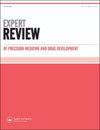Combining immune checkpoint inhibitors with locoregional therapies in hepatocellular carcinoma
IF 1.2
Q4 PHARMACOLOGY & PHARMACY
Expert Review of Precision Medicine and Drug Development
Pub Date : 2021-12-27
DOI:10.1080/23808993.2022.2020091
引用次数: 1
Abstract
The phase III IMbrave150 trial evaluating the combination of the PD-L1 inhibitor atezolizumab plus bevacizumab has recently represented an important step forward in the medical management of HCC [1]. According to the results of this study, advanced HCC patients receiving atezolizumab – bevacizumab reported statistically significant and clinically meaningful improvements in terms of overall survival (OS), progression-free survival (PFS), objective response rate (ORR) and complete response rate, compared with sorafenib monotherapy [2,3]. Of note, immunotherapy seems to have find its role in the management of HCC as part of combinatorial strategies, as also witnessed by the recently published results of the phase I/II HIMALAYA trial [4]. In addition, an interesting line of research currently concerns the addition of locoregional therapies to immune checkpoint inhibitors, in order to produce a synergistic effect and improve clinical outcomes [5]. Locoregional treatments, including transarterial chemoembolization (TACE), radiofrequency ablation (RFA), selective internal radiation therapy (SIRT), and stereotactic body radiotherapy (SBRT), are considered of pivotal importance in the management of HCC patients [6]. These approaches are currently under evaluation in combination with immunotherapy, since locoregional therapies not only attack primary tumors but have been also suggested to boost antitumor immunity though the release of neoplasm antigens [7]. Recent years have seen the presentation or publication of several clinical trials combining immune checkpoint inhibitors with locoregional treatments (Table 1). A phase I/II trial published by Duffy and colleagues investigated the role of the combination of the CTLA-4 inhibitor tremelimumab plus TACE or RFA in Barcelona Clinic Liver Cancer (BCLC) Stage B and C HCC patients [8]. According to the results of this study, partial response (PR) was observed in 26.3% of cases, with 6-month PFS of 57.1% and median OS of 12.3 months (95% CI, 9.3–15.4). An interesting finding of this study concerns the HCVpositive population, with 12 of 14 HCC patients experiencing a notable reduction in viral load and a dramatical increase in CD8 + T cells reported in tumor biopsies after 6 weeks [8]. In another phase II trial conducted by Zhao and colleagues, the authors evaluated the role of thermal ablation plus a PD-1 inhibitor (pembrolizumab or nivolumab or JS001) in 50 HCC patients [9]. Median PFS, median Time to Progression (TTP), and median OS were 5 months (95% CI, 2.9–7.1), 6.1 months (95% CI, 2.6–11.2), and 16.9 months (95% CI, 7.7–26.1), respectively [9]. Another strategy under assessment is based on the combination of TACE plus immunotherapy. With efficacy data still pending, the preliminary results of the PETAL phase I/II study on conventional TACE followed by the PD-1 inhibitor pembrolizumab reported an acceptable safety profile for this combination [10]. Similarly, the IMMUTACE phase II trial is investigating the efficacy and tolerability of TACE plus nivolumab in intermediate-stage HCC patients (NCT03572582), and other trials are evaluating double checkpoint blockade with durvalumab plus tremelimumab combined with RFA, TACE or cryoablation (NCT02821754) or following TACE (NCT03638141) in HCC patients with advanced disease. As witnessed by the presentation of the SORAMIC and SARAH trials on SIRT alone or combined with sorafenib, SIRT is under assessment in combination with immunotherapy [11,12]. A singlecenter, nonrandomized phase II trial conducted by Tai and colleagues evaluated the role of Y90-radioembolization plus nivolumab in Asian HCC patients with advanced disease (NCT03033446) [13]; interestingly, the ORR and disease control rate (DCR) were 31% and 58.3%, respectively, with median PFS of 4.6 months and median OS of 15.1 months [13]. Similarly, several ongoing studies are investigating SIRT plus pembrolizumab (NCT03099564) or nivolumab (NCT02837029). Another promising combination of immunotherapy plus locoregional therapies concerns the use of SBRT, including a phase II trial evaluating pembrolizumab – SBRT following disease progression during first-line sorafenib (NCT03316872). Despite therapeutic combinations of immune checkpoint inhibitors and locoregional treatments appear promising, some considerations come to mind. First, locoregional approaches have been suggested to increase hypoxia and to release several cytokines (including, among the others, TGFbeta, VEGF-1, VEGF-2), which in turn are able to impair the efficacy of antitumor immune response [14]. Based on these premises, and similar to what observed in recent trials (e.g. IMbrave150, KEYNOTE-524, etc.), studies exploring combinations of locoregional therapies with immunotherapy and antiangiogenic agents should be prioritized and supported in the near future [15–18]. For example, the results of the LEAP-免疫检查点抑制剂联合局部治疗肝细胞癌
评估PD-L1抑制剂atezolizumab与贝伐单抗联合用药的III期IMbrave150试验最近代表着HCC医疗管理向前迈出了重要一步[1]。根据这项研究的结果,与索拉非尼单药治疗相比,接受atezolizumab-贝伐单抗治疗的晚期HCC患者在总生存期(OS)、无进展生存期(PFS)、客观缓解率(ORR)和完全缓解率方面报告了具有统计学意义和临床意义的改善[2,3]。值得注意的是,免疫疗法似乎已经发现其作为组合策略的一部分在HCC管理中的作用,最近发表的HIMALAYA I/II期试验结果也证明了这一点[4]。此外,目前一项有趣的研究涉及在免疫检查点抑制剂中添加局部区域疗法,以产生协同效应并改善临床结果[5]。局部区域治疗,包括经动脉化疗栓塞(TACE)、射频消融(RFA)、选择性内部放射治疗(SIRT)和立体定向身体放射治疗(SBRT),被认为在HCC患者的管理中至关重要[6]。这些方法目前正在与免疫疗法相结合进行评估,因为局部治疗不仅可以攻击原发性肿瘤,还可以通过释放肿瘤抗原来增强抗肿瘤免疫力[7]。近年来,出现或发表了几项将免疫检查点抑制剂与局部治疗相结合的临床试验(表1)。Duffy及其同事发表的一项I/II期试验研究了CTLA-4抑制剂tremlimumab联合TACE或RFA在巴塞罗那临床癌症(BCLC)B期和C期HCC患者中的作用[8]。根据本研究的结果,26.3%的病例观察到部分缓解(PR),6个月PFS为57.1%,中位OS为12.3个月(95%CI,9.3-15.4)。本研究的一个有趣发现涉及HCV阳性人群,14名HCC患者中有12名在6周后的肿瘤活检中报告病毒载量显著降低,CD8+T细胞显著增加[8]。在赵及其同事进行的另一项II期试验中,作者评估了热消融加PD-1抑制剂(pembrolizumab或nivolumab或JS001)在50名HCC患者中的作用[9]。中位PFS、中位进展时间(TTP)和中位OS分别为5个月(95%CI,2.9-7.1)、6.1个月(95%CI,2.6-11.2)和16.9个月(95%CI,7.7-26.1)[9]。另一个正在评估的策略是基于TACE和免疫疗法的组合。疗效数据尚待确定,PETAL常规TACE I/II期研究的初步结果表明,PD-1抑制剂pembrolizumab对该组合具有可接受的安全性[10]。同样,IMMUTACE II期试验正在研究TACE加尼沃单抗治疗中期HCC患者的疗效和耐受性(NCT03572582),其他试验正在评估杜伐单抗加特耳利单抗联合RFA、TACE或冷冻消融(NCT02821754)或TACE后(NCT03638141)对晚期HCC患者进行双检查点阻断。正如SORAMIC和SARAH对SIRT单独或与索拉非尼联合进行的试验所证明的那样,SIRT与免疫疗法联合进行评估[11,12]。Tai及其同事进行的一项单中心非随机II期试验评估了Y90放射性栓塞加nivolumab在亚洲晚期HCC患者中的作用(NCT03033446)[13];有趣的是,ORR和疾病控制率(DCR)分别为31%和58.3%,中位PFS为4.6个月,中位OS为15.1个月[13]。同样,一些正在进行的研究正在调查SIRT加pembrolizumab(NCT03099564)或nivolumab(NCT02837029)。免疫疗法加局部区域疗法的另一个有前景的组合涉及SBRT的使用,包括在索拉非尼一线治疗期间评估pembrolizumab-SBRT的II期试验(NCT03316872)。尽管免疫检查点抑制剂和局部治疗的治疗组合似乎很有前景,但还是有一些考虑因素。首先,已经提出了局部区域方法来增加缺氧并释放几种细胞因子(包括TGFβ、VEGF-1、VEGF-2等),这些细胞因子反过来能够削弱抗肿瘤免疫反应的功效[14]。基于这些前提,与最近的试验(如IMbrave150、KEYNOTE-524等)中观察到的情况类似,探索局部区域疗法与免疫疗法和抗血管生成药物组合的研究应在不久的将来得到优先考虑和支持[15-18]。例如,LEAP的结果-
本文章由计算机程序翻译,如有差异,请以英文原文为准。
求助全文
约1分钟内获得全文
求助全文
来源期刊

Expert Review of Precision Medicine and Drug Development
PHARMACOLOGY & PHARMACY-
CiteScore
2.30
自引率
0.00%
发文量
9
期刊介绍:
Expert Review of Precision Medicine and Drug Development publishes primarily review articles covering the development and clinical application of medicine to be used in a personalized therapy setting; in addition, the journal also publishes original research and commentary-style articles. In an era where medicine is recognizing that a one-size-fits-all approach is not always appropriate, it has become necessary to identify patients responsive to treatments and treat patient populations using a tailored approach. Areas covered include: Development and application of drugs targeted to specific genotypes and populations, as well as advanced diagnostic technologies and significant biomarkers that aid in this. Clinical trials and case studies within personalized therapy and drug development. Screening, prediction and prevention of disease, prediction of adverse events, treatment monitoring, effects of metabolomics and microbiomics on treatment. Secondary population research, genome-wide association studies, disease–gene association studies, personal genome technologies. Ethical and cost–benefit issues, the impact to healthcare and business infrastructure, and regulatory issues.
 求助内容:
求助内容: 应助结果提醒方式:
应助结果提醒方式:


